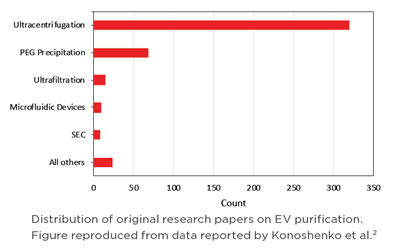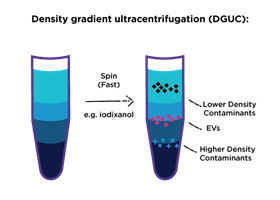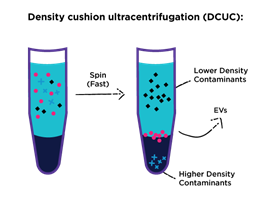Why should I choose ultracentrifugation as the preferred method for extracellular vesicle purification?


Extracellular Vesicles (EVs), most notably exosomes, have shown tremendous promise as biomarkers and therapeutics. However, many of the available techniques for EV purification generate broad populations of vesicles that are unsuitable for subsequent characterization and application.
Ultracentrifugation (UC) is broadly considered the gold standard for EV purification due to its capacity to reproducibly isolate specific subpopulations of EVs.1
EV Purification with UC
UC affords exceptional reliability

EVs are heterogenous with respect to size, composition, and function. This variation represents a fundamental challenge for EV research, as accurate analysis of physical and functional characteristics of EV populations necessitates selective and reliable purification. Due to the multitude of advantages UC offers, it is the most commonly used technique for EV purification.2
Simple purification using Differential UC

Simple but efficient, differential UC (DUC) relies on multiple rounds of centrifugation to selectively eliminate contaminants and pellet EVs.3 The principal advantages of DUC are minimal hands-on time, high throughput, high yield, and low per-sample cost. Additionally, DUC is suitable for a range of EV purification workflows from numerous small samples to multi-liter batches.
Reach higher purity with density modifiers


For high purity EV preparations, density modifiers such as sucrose and iodixanol are commonly utilized. Density cushion UC (DCUC) relies on gently pelleting EVs onto a ‘cushion’ of density material,4 while density gradient UC (DGUC) employs a medium of graded density material to separate EV subpopulations based on their buoyant densities.5 When EV purity is a top priority, density-based separations are essential.
Summary
Ultracentrifugation possesses several distinct advantages and is currently the most widely used method for EV purification. Moreover, UC as a platform is broadly suitable for a variety of EV applications. Learn more about how UC can enhance your EV workflow here.
References-
Saenz-Cuesta, et al. (2015). Front Immunol, 6, 50. DOI: 10.3389/fimmu.2015.00050
-
Konoshenko, et al. (2018). Biomed Res Int, 8545347. DOI: 10.1155/2018/8545347
-
Sharma, et al. (2020). Sci Rep, 10, 13327. DOI: 10.1038/s41598-020-70245-1
-
Duong et al. (2019). PLoS One, 15, e0215324. DOI: 10.1371/journal.pone.0236914
-
Van de Vlekkert et al. (2020). 10, e3576 DOI: 10.21769/BioProtoc.3576

